A Detailed Analysis of the Teleological Concept of God & Existence
VerifiedAdded on 2023/05/31
|11
|3367
|445
Essay
AI Summary
This essay provides a comprehensive analysis of the teleological concept of God, exploring various design arguments, including analogical, deductive, and abductive designs. It delves into Humean objections and alternative explanations like Darwinian theory. The essay examines the interference of teleological design in proving God's existence, evaluating arguments from thinkers like Hume and Paly. It also discusses agent and mechanical explanations, disputes, and the role of causation and evidence. The essay concludes by summarizing the arguments for and against the existence of God based on teleological reasoning, offering a nuanced perspective on the philosophical debate. Desklib offers similar essays and solved assignments for students.
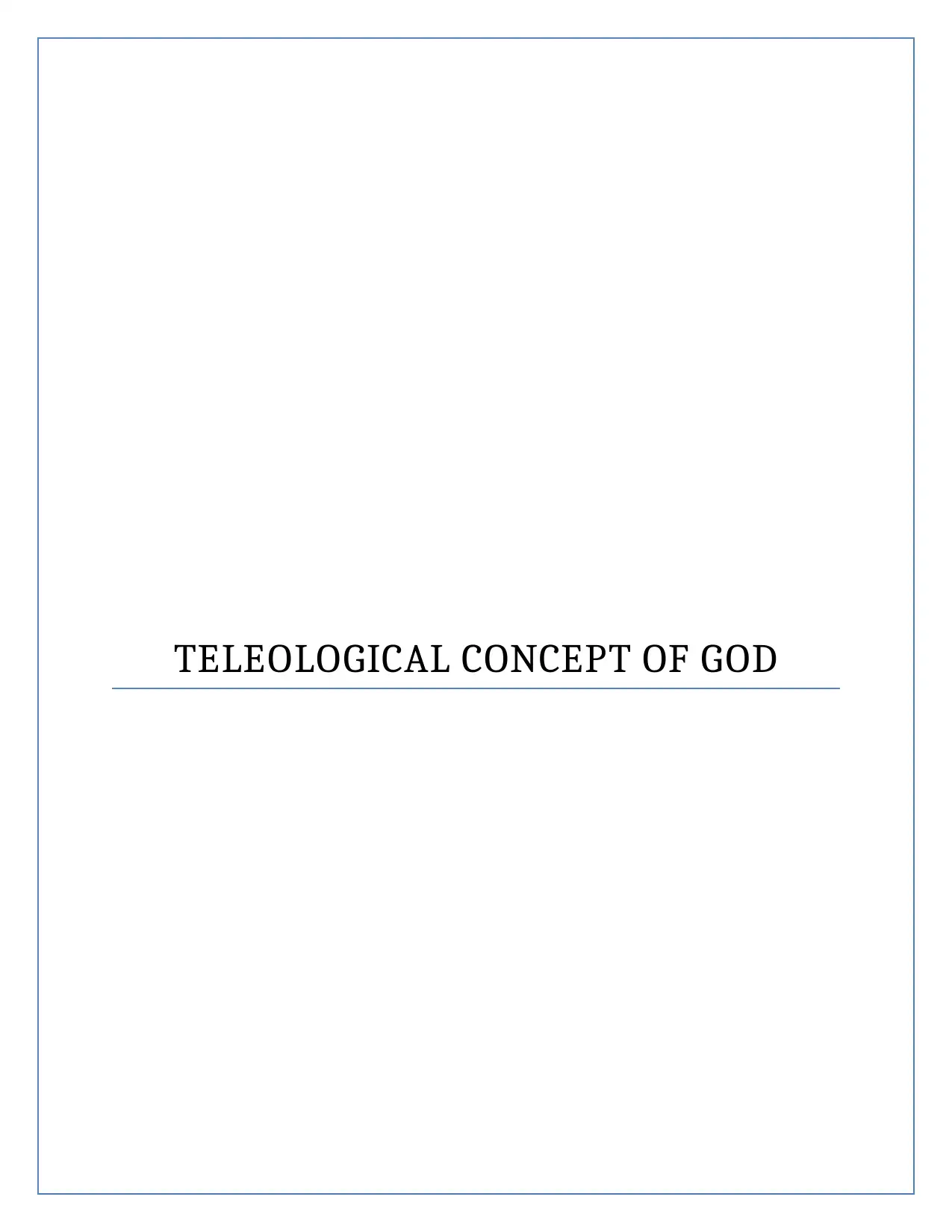
TELEOLOGICAL CONCEPT OF GOD
Paraphrase This Document
Need a fresh take? Get an instant paraphrase of this document with our AI Paraphraser
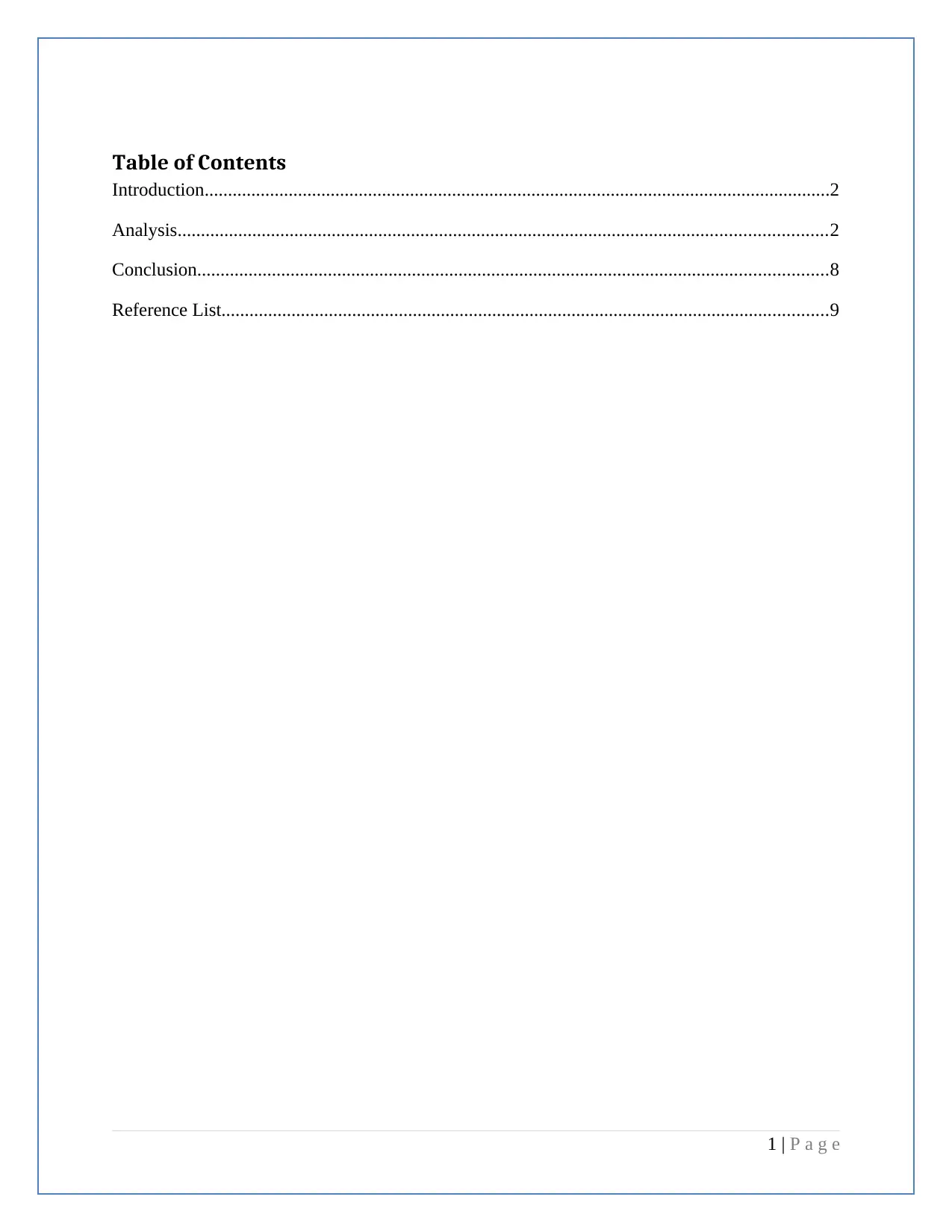
Table of Contents
Introduction......................................................................................................................................2
Analysis...........................................................................................................................................2
Conclusion.......................................................................................................................................8
Reference List..................................................................................................................................9
1 | P a g e
Introduction......................................................................................................................................2
Analysis...........................................................................................................................................2
Conclusion.......................................................................................................................................8
Reference List..................................................................................................................................9
1 | P a g e
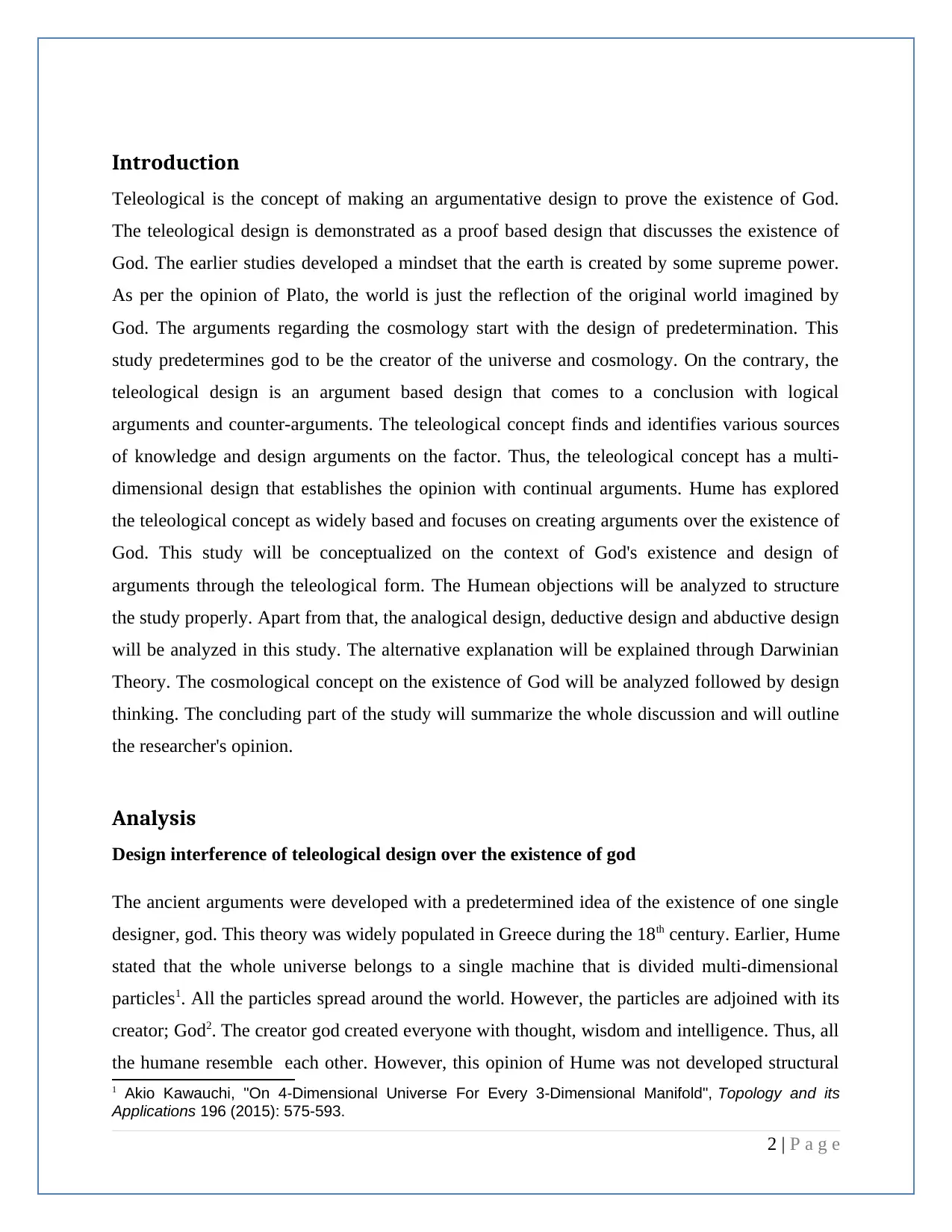
Introduction
Teleological is the concept of making an argumentative design to prove the existence of God.
The teleological design is demonstrated as a proof based design that discusses the existence of
God. The earlier studies developed a mindset that the earth is created by some supreme power.
As per the opinion of Plato, the world is just the reflection of the original world imagined by
God. The arguments regarding the cosmology start with the design of predetermination. This
study predetermines god to be the creator of the universe and cosmology. On the contrary, the
teleological design is an argument based design that comes to a conclusion with logical
arguments and counter-arguments. The teleological concept finds and identifies various sources
of knowledge and design arguments on the factor. Thus, the teleological concept has a multi-
dimensional design that establishes the opinion with continual arguments. Hume has explored
the teleological concept as widely based and focuses on creating arguments over the existence of
God. This study will be conceptualized on the context of God's existence and design of
arguments through the teleological form. The Humean objections will be analyzed to structure
the study properly. Apart from that, the analogical design, deductive design and abductive design
will be analyzed in this study. The alternative explanation will be explained through Darwinian
Theory. The cosmological concept on the existence of God will be analyzed followed by design
thinking. The concluding part of the study will summarize the whole discussion and will outline
the researcher's opinion.
Analysis
Design interference of teleological design over the existence of god
The ancient arguments were developed with a predetermined idea of the existence of one single
designer, god. This theory was widely populated in Greece during the 18th century. Earlier, Hume
stated that the whole universe belongs to a single machine that is divided multi-dimensional
particles1. All the particles spread around the world. However, the particles are adjoined with its
creator; God2. The creator god created everyone with thought, wisdom and intelligence. Thus, all
the humane resemble each other. However, this opinion of Hume was not developed structural
1 Akio Kawauchi, "On 4-Dimensional Universe For Every 3-Dimensional Manifold", Topology and its
Applications 196 (2015): 575-593.
2 | P a g e
Teleological is the concept of making an argumentative design to prove the existence of God.
The teleological design is demonstrated as a proof based design that discusses the existence of
God. The earlier studies developed a mindset that the earth is created by some supreme power.
As per the opinion of Plato, the world is just the reflection of the original world imagined by
God. The arguments regarding the cosmology start with the design of predetermination. This
study predetermines god to be the creator of the universe and cosmology. On the contrary, the
teleological design is an argument based design that comes to a conclusion with logical
arguments and counter-arguments. The teleological concept finds and identifies various sources
of knowledge and design arguments on the factor. Thus, the teleological concept has a multi-
dimensional design that establishes the opinion with continual arguments. Hume has explored
the teleological concept as widely based and focuses on creating arguments over the existence of
God. This study will be conceptualized on the context of God's existence and design of
arguments through the teleological form. The Humean objections will be analyzed to structure
the study properly. Apart from that, the analogical design, deductive design and abductive design
will be analyzed in this study. The alternative explanation will be explained through Darwinian
Theory. The cosmological concept on the existence of God will be analyzed followed by design
thinking. The concluding part of the study will summarize the whole discussion and will outline
the researcher's opinion.
Analysis
Design interference of teleological design over the existence of god
The ancient arguments were developed with a predetermined idea of the existence of one single
designer, god. This theory was widely populated in Greece during the 18th century. Earlier, Hume
stated that the whole universe belongs to a single machine that is divided multi-dimensional
particles1. All the particles spread around the world. However, the particles are adjoined with its
creator; God2. The creator god created everyone with thought, wisdom and intelligence. Thus, all
the humane resemble each other. However, this opinion of Hume was not developed structural
1 Akio Kawauchi, "On 4-Dimensional Universe For Every 3-Dimensional Manifold", Topology and its
Applications 196 (2015): 575-593.
2 | P a g e
⊘ This is a preview!⊘
Do you want full access?
Subscribe today to unlock all pages.

Trusted by 1+ million students worldwide
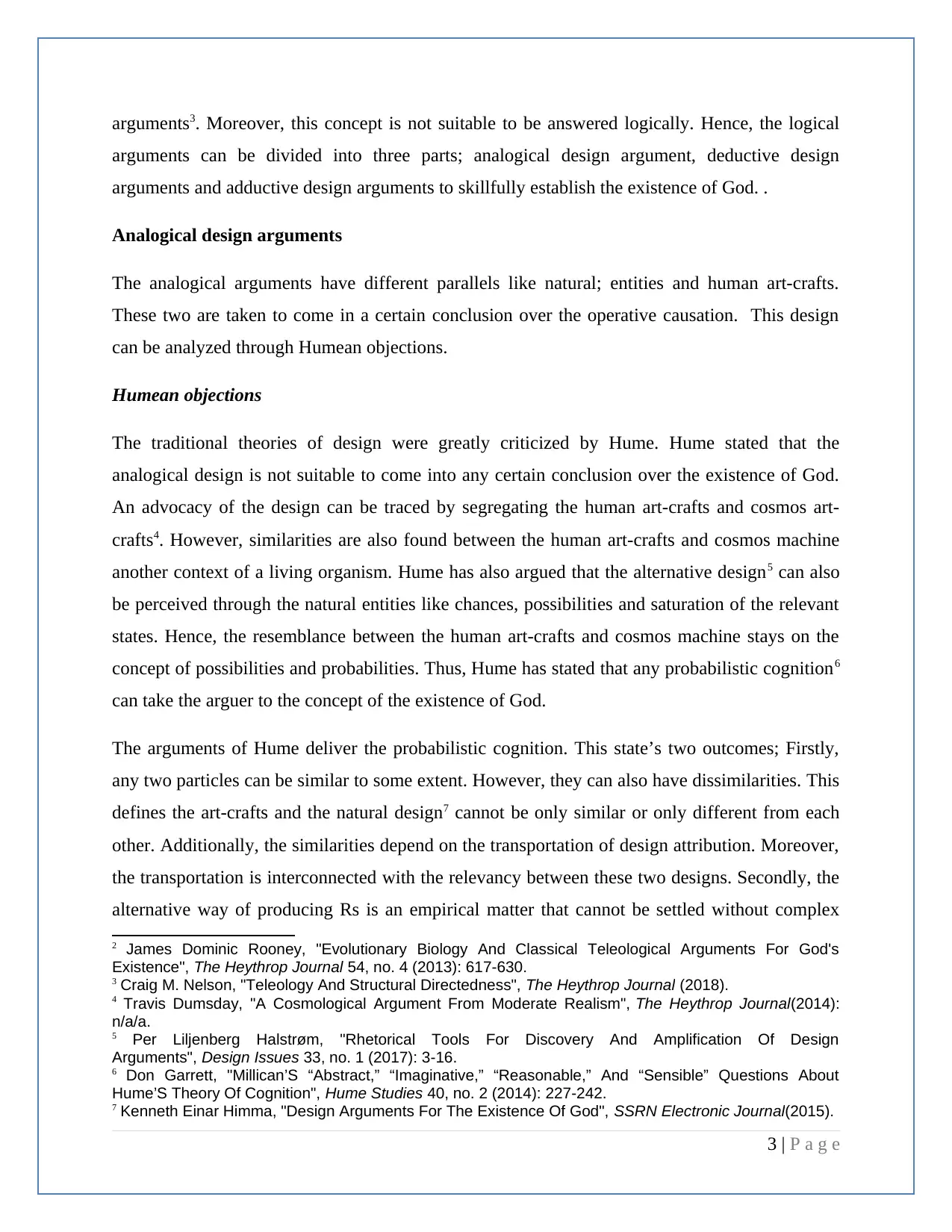
arguments3. Moreover, this concept is not suitable to be answered logically. Hence, the logical
arguments can be divided into three parts; analogical design argument, deductive design
arguments and adductive design arguments to skillfully establish the existence of God. .
Analogical design arguments
The analogical arguments have different parallels like natural; entities and human art-crafts.
These two are taken to come in a certain conclusion over the operative causation. This design
can be analyzed through Humean objections.
Humean objections
The traditional theories of design were greatly criticized by Hume. Hume stated that the
analogical design is not suitable to come into any certain conclusion over the existence of God.
An advocacy of the design can be traced by segregating the human art-crafts and cosmos art-
crafts4. However, similarities are also found between the human art-crafts and cosmos machine
another context of a living organism. Hume has also argued that the alternative design5 can also
be perceived through the natural entities like chances, possibilities and saturation of the relevant
states. Hence, the resemblance between the human art-crafts and cosmos machine stays on the
concept of possibilities and probabilities. Thus, Hume has stated that any probabilistic cognition6
can take the arguer to the concept of the existence of God.
The arguments of Hume deliver the probabilistic cognition. This state’s two outcomes; Firstly,
any two particles can be similar to some extent. However, they can also have dissimilarities. This
defines the art-crafts and the natural design7 cannot be only similar or only different from each
other. Additionally, the similarities depend on the transportation of design attribution. Moreover,
the transportation is interconnected with the relevancy between these two designs. Secondly, the
alternative way of producing Rs is an empirical matter that cannot be settled without complex
2 James Dominic Rooney, "Evolutionary Biology And Classical Teleological Arguments For God's
Existence", The Heythrop Journal 54, no. 4 (2013): 617-630.
3 Craig M. Nelson, "Teleology And Structural Directedness", The Heythrop Journal (2018).
4 Travis Dumsday, "A Cosmological Argument From Moderate Realism", The Heythrop Journal(2014):
n/a/a.
5 Per Liljenberg Halstrøm, "Rhetorical Tools For Discovery And Amplification Of Design
Arguments", Design Issues 33, no. 1 (2017): 3-16.
6 Don Garrett, "Millican’S “Abstract,” “Imaginative,” “Reasonable,” And “Sensible” Questions About
Hume’S Theory Of Cognition", Hume Studies 40, no. 2 (2014): 227-242.
7 Kenneth Einar Himma, "Design Arguments For The Existence Of God", SSRN Electronic Journal(2015).
3 | P a g e
arguments can be divided into three parts; analogical design argument, deductive design
arguments and adductive design arguments to skillfully establish the existence of God. .
Analogical design arguments
The analogical arguments have different parallels like natural; entities and human art-crafts.
These two are taken to come in a certain conclusion over the operative causation. This design
can be analyzed through Humean objections.
Humean objections
The traditional theories of design were greatly criticized by Hume. Hume stated that the
analogical design is not suitable to come into any certain conclusion over the existence of God.
An advocacy of the design can be traced by segregating the human art-crafts and cosmos art-
crafts4. However, similarities are also found between the human art-crafts and cosmos machine
another context of a living organism. Hume has also argued that the alternative design5 can also
be perceived through the natural entities like chances, possibilities and saturation of the relevant
states. Hence, the resemblance between the human art-crafts and cosmos machine stays on the
concept of possibilities and probabilities. Thus, Hume has stated that any probabilistic cognition6
can take the arguer to the concept of the existence of God.
The arguments of Hume deliver the probabilistic cognition. This state’s two outcomes; Firstly,
any two particles can be similar to some extent. However, they can also have dissimilarities. This
defines the art-crafts and the natural design7 cannot be only similar or only different from each
other. Additionally, the similarities depend on the transportation of design attribution. Moreover,
the transportation is interconnected with the relevancy between these two designs. Secondly, the
alternative way of producing Rs is an empirical matter that cannot be settled without complex
2 James Dominic Rooney, "Evolutionary Biology And Classical Teleological Arguments For God's
Existence", The Heythrop Journal 54, no. 4 (2013): 617-630.
3 Craig M. Nelson, "Teleology And Structural Directedness", The Heythrop Journal (2018).
4 Travis Dumsday, "A Cosmological Argument From Moderate Realism", The Heythrop Journal(2014):
n/a/a.
5 Per Liljenberg Halstrøm, "Rhetorical Tools For Discovery And Amplification Of Design
Arguments", Design Issues 33, no. 1 (2017): 3-16.
6 Don Garrett, "Millican’S “Abstract,” “Imaginative,” “Reasonable,” And “Sensible” Questions About
Hume’S Theory Of Cognition", Hume Studies 40, no. 2 (2014): 227-242.
7 Kenneth Einar Himma, "Design Arguments For The Existence Of God", SSRN Electronic Journal(2015).
3 | P a g e
Paraphrase This Document
Need a fresh take? Get an instant paraphrase of this document with our AI Paraphraser
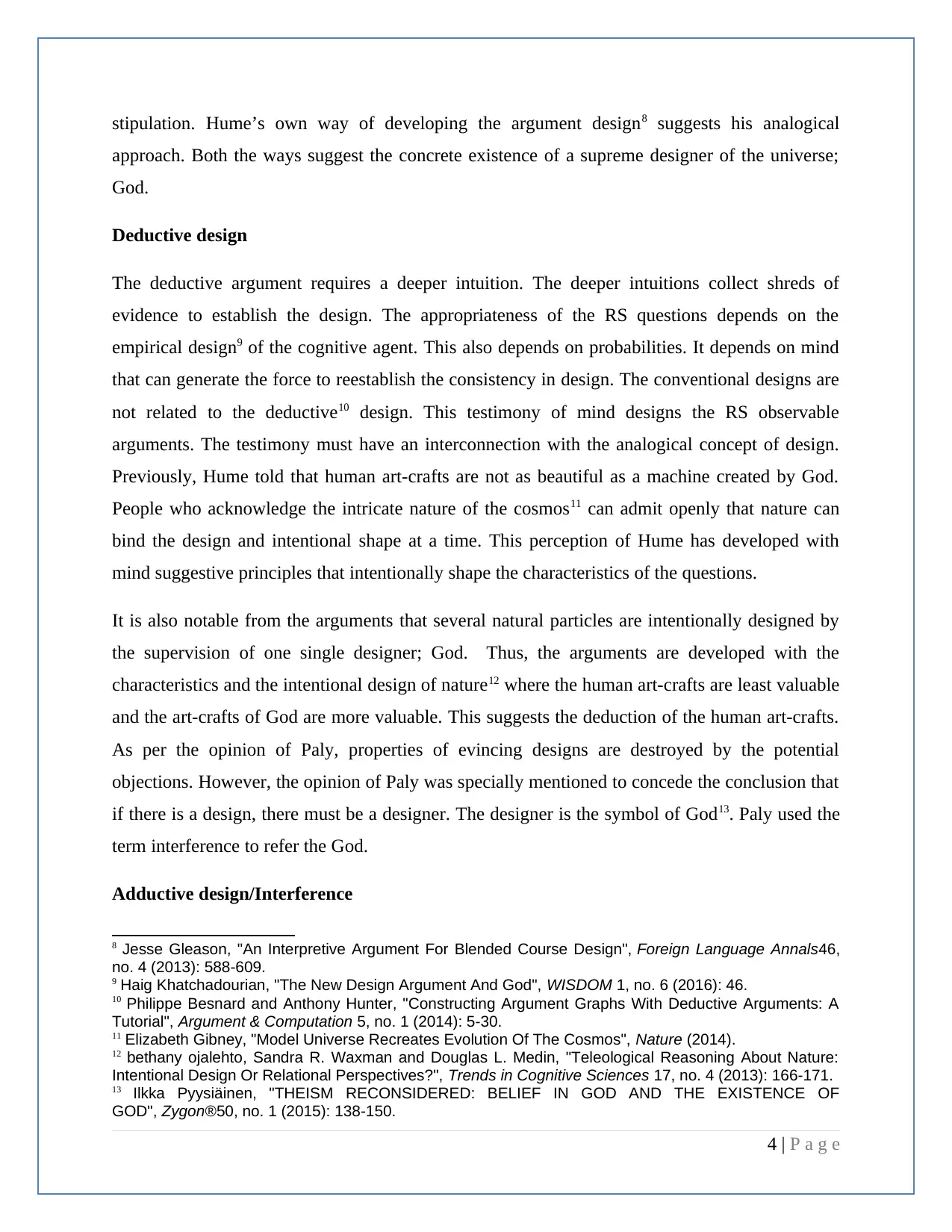
stipulation. Hume’s own way of developing the argument design8 suggests his analogical
approach. Both the ways suggest the concrete existence of a supreme designer of the universe;
God.
Deductive design
The deductive argument requires a deeper intuition. The deeper intuitions collect shreds of
evidence to establish the design. The appropriateness of the RS questions depends on the
empirical design9 of the cognitive agent. This also depends on probabilities. It depends on mind
that can generate the force to reestablish the consistency in design. The conventional designs are
not related to the deductive10 design. This testimony of mind designs the RS observable
arguments. The testimony must have an interconnection with the analogical concept of design.
Previously, Hume told that human art-crafts are not as beautiful as a machine created by God.
People who acknowledge the intricate nature of the cosmos11 can admit openly that nature can
bind the design and intentional shape at a time. This perception of Hume has developed with
mind suggestive principles that intentionally shape the characteristics of the questions.
It is also notable from the arguments that several natural particles are intentionally designed by
the supervision of one single designer; God. Thus, the arguments are developed with the
characteristics and the intentional design of nature12 where the human art-crafts are least valuable
and the art-crafts of God are more valuable. This suggests the deduction of the human art-crafts.
As per the opinion of Paly, properties of evincing designs are destroyed by the potential
objections. However, the opinion of Paly was specially mentioned to concede the conclusion that
if there is a design, there must be a designer. The designer is the symbol of God13. Paly used the
term interference to refer the God.
Adductive design/Interference
8 Jesse Gleason, "An Interpretive Argument For Blended Course Design", Foreign Language Annals46,
no. 4 (2013): 588-609.
9 Haig Khatchadourian, "The New Design Argument And God", WISDOM 1, no. 6 (2016): 46.
10 Philippe Besnard and Anthony Hunter, "Constructing Argument Graphs With Deductive Arguments: A
Tutorial", Argument & Computation 5, no. 1 (2014): 5-30.
11 Elizabeth Gibney, "Model Universe Recreates Evolution Of The Cosmos", Nature (2014).
12 bethany ojalehto, Sandra R. Waxman and Douglas L. Medin, "Teleological Reasoning About Nature:
Intentional Design Or Relational Perspectives?", Trends in Cognitive Sciences 17, no. 4 (2013): 166-171.
13 Ilkka Pyysiäinen, "THEISM RECONSIDERED: BELIEF IN GOD AND THE EXISTENCE OF
GOD", Zygon®50, no. 1 (2015): 138-150.
4 | P a g e
approach. Both the ways suggest the concrete existence of a supreme designer of the universe;
God.
Deductive design
The deductive argument requires a deeper intuition. The deeper intuitions collect shreds of
evidence to establish the design. The appropriateness of the RS questions depends on the
empirical design9 of the cognitive agent. This also depends on probabilities. It depends on mind
that can generate the force to reestablish the consistency in design. The conventional designs are
not related to the deductive10 design. This testimony of mind designs the RS observable
arguments. The testimony must have an interconnection with the analogical concept of design.
Previously, Hume told that human art-crafts are not as beautiful as a machine created by God.
People who acknowledge the intricate nature of the cosmos11 can admit openly that nature can
bind the design and intentional shape at a time. This perception of Hume has developed with
mind suggestive principles that intentionally shape the characteristics of the questions.
It is also notable from the arguments that several natural particles are intentionally designed by
the supervision of one single designer; God. Thus, the arguments are developed with the
characteristics and the intentional design of nature12 where the human art-crafts are least valuable
and the art-crafts of God are more valuable. This suggests the deduction of the human art-crafts.
As per the opinion of Paly, properties of evincing designs are destroyed by the potential
objections. However, the opinion of Paly was specially mentioned to concede the conclusion that
if there is a design, there must be a designer. The designer is the symbol of God13. Paly used the
term interference to refer the God.
Adductive design/Interference
8 Jesse Gleason, "An Interpretive Argument For Blended Course Design", Foreign Language Annals46,
no. 4 (2013): 588-609.
9 Haig Khatchadourian, "The New Design Argument And God", WISDOM 1, no. 6 (2016): 46.
10 Philippe Besnard and Anthony Hunter, "Constructing Argument Graphs With Deductive Arguments: A
Tutorial", Argument & Computation 5, no. 1 (2014): 5-30.
11 Elizabeth Gibney, "Model Universe Recreates Evolution Of The Cosmos", Nature (2014).
12 bethany ojalehto, Sandra R. Waxman and Douglas L. Medin, "Teleological Reasoning About Nature:
Intentional Design Or Relational Perspectives?", Trends in Cognitive Sciences 17, no. 4 (2013): 166-171.
13 Ilkka Pyysiäinen, "THEISM RECONSIDERED: BELIEF IN GOD AND THE EXISTENCE OF
GOD", Zygon®50, no. 1 (2015): 138-150.
4 | P a g e
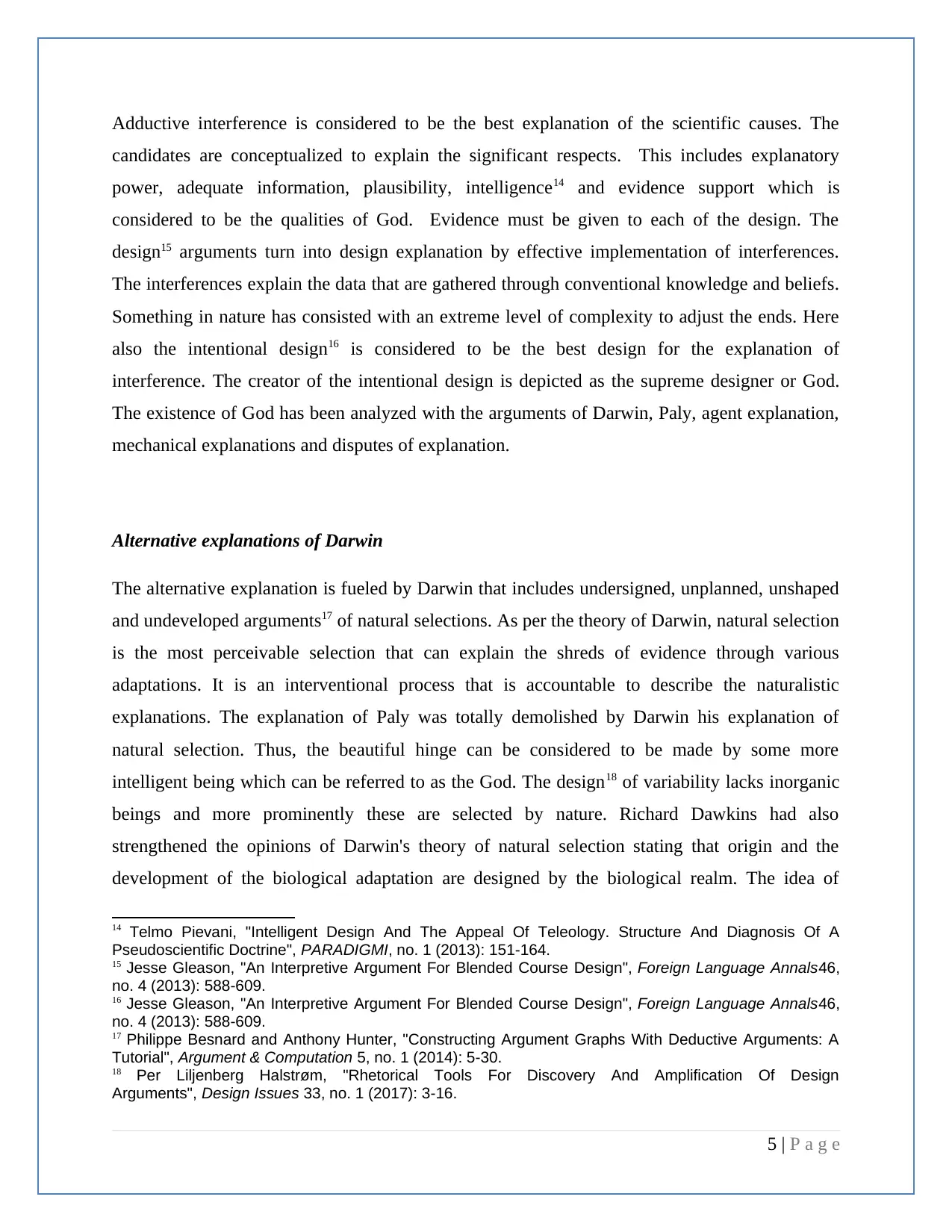
Adductive interference is considered to be the best explanation of the scientific causes. The
candidates are conceptualized to explain the significant respects. This includes explanatory
power, adequate information, plausibility, intelligence14 and evidence support which is
considered to be the qualities of God. Evidence must be given to each of the design. The
design15 arguments turn into design explanation by effective implementation of interferences.
The interferences explain the data that are gathered through conventional knowledge and beliefs.
Something in nature has consisted with an extreme level of complexity to adjust the ends. Here
also the intentional design16 is considered to be the best design for the explanation of
interference. The creator of the intentional design is depicted as the supreme designer or God.
The existence of God has been analyzed with the arguments of Darwin, Paly, agent explanation,
mechanical explanations and disputes of explanation.
Alternative explanations of Darwin
The alternative explanation is fueled by Darwin that includes undersigned, unplanned, unshaped
and undeveloped arguments17 of natural selections. As per the theory of Darwin, natural selection
is the most perceivable selection that can explain the shreds of evidence through various
adaptations. It is an interventional process that is accountable to describe the naturalistic
explanations. The explanation of Paly was totally demolished by Darwin his explanation of
natural selection. Thus, the beautiful hinge can be considered to be made by some more
intelligent being which can be referred to as the God. The design18 of variability lacks inorganic
beings and more prominently these are selected by nature. Richard Dawkins had also
strengthened the opinions of Darwin's theory of natural selection stating that origin and the
development of the biological adaptation are designed by the biological realm. The idea of
14 Telmo Pievani, "Intelligent Design And The Appeal Of Teleology. Structure And Diagnosis Of A
Pseudoscientific Doctrine", PARADIGMI, no. 1 (2013): 151-164.
15 Jesse Gleason, "An Interpretive Argument For Blended Course Design", Foreign Language Annals46,
no. 4 (2013): 588-609.
16 Jesse Gleason, "An Interpretive Argument For Blended Course Design", Foreign Language Annals46,
no. 4 (2013): 588-609.
17 Philippe Besnard and Anthony Hunter, "Constructing Argument Graphs With Deductive Arguments: A
Tutorial", Argument & Computation 5, no. 1 (2014): 5-30.
18 Per Liljenberg Halstrøm, "Rhetorical Tools For Discovery And Amplification Of Design
Arguments", Design Issues 33, no. 1 (2017): 3-16.
5 | P a g e
candidates are conceptualized to explain the significant respects. This includes explanatory
power, adequate information, plausibility, intelligence14 and evidence support which is
considered to be the qualities of God. Evidence must be given to each of the design. The
design15 arguments turn into design explanation by effective implementation of interferences.
The interferences explain the data that are gathered through conventional knowledge and beliefs.
Something in nature has consisted with an extreme level of complexity to adjust the ends. Here
also the intentional design16 is considered to be the best design for the explanation of
interference. The creator of the intentional design is depicted as the supreme designer or God.
The existence of God has been analyzed with the arguments of Darwin, Paly, agent explanation,
mechanical explanations and disputes of explanation.
Alternative explanations of Darwin
The alternative explanation is fueled by Darwin that includes undersigned, unplanned, unshaped
and undeveloped arguments17 of natural selections. As per the theory of Darwin, natural selection
is the most perceivable selection that can explain the shreds of evidence through various
adaptations. It is an interventional process that is accountable to describe the naturalistic
explanations. The explanation of Paly was totally demolished by Darwin his explanation of
natural selection. Thus, the beautiful hinge can be considered to be made by some more
intelligent being which can be referred to as the God. The design18 of variability lacks inorganic
beings and more prominently these are selected by nature. Richard Dawkins had also
strengthened the opinions of Darwin's theory of natural selection stating that origin and the
development of the biological adaptation are designed by the biological realm. The idea of
14 Telmo Pievani, "Intelligent Design And The Appeal Of Teleology. Structure And Diagnosis Of A
Pseudoscientific Doctrine", PARADIGMI, no. 1 (2013): 151-164.
15 Jesse Gleason, "An Interpretive Argument For Blended Course Design", Foreign Language Annals46,
no. 4 (2013): 588-609.
16 Jesse Gleason, "An Interpretive Argument For Blended Course Design", Foreign Language Annals46,
no. 4 (2013): 588-609.
17 Philippe Besnard and Anthony Hunter, "Constructing Argument Graphs With Deductive Arguments: A
Tutorial", Argument & Computation 5, no. 1 (2014): 5-30.
18 Per Liljenberg Halstrøm, "Rhetorical Tools For Discovery And Amplification Of Design
Arguments", Design Issues 33, no. 1 (2017): 3-16.
5 | P a g e
⊘ This is a preview!⊘
Do you want full access?
Subscribe today to unlock all pages.

Trusted by 1+ million students worldwide
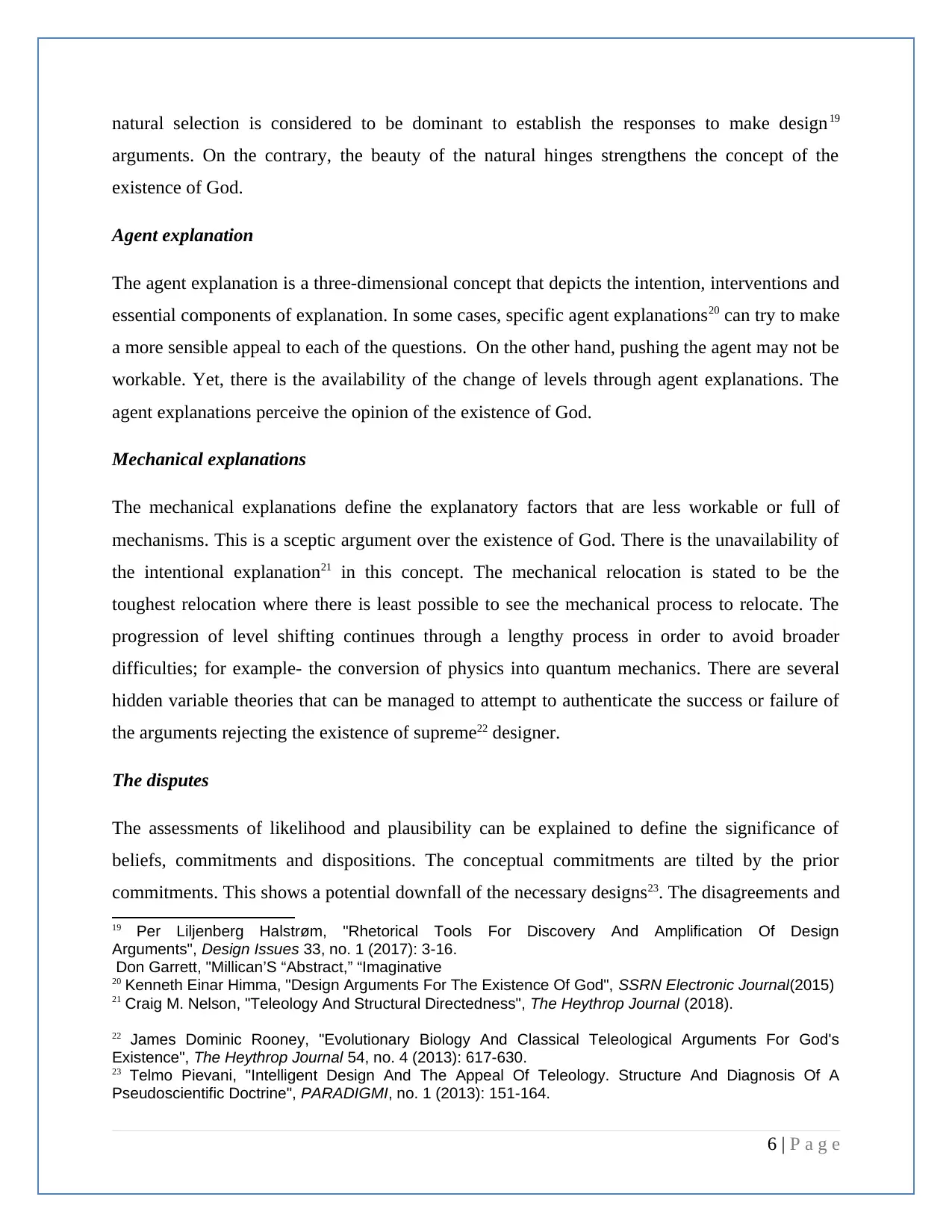
natural selection is considered to be dominant to establish the responses to make design19
arguments. On the contrary, the beauty of the natural hinges strengthens the concept of the
existence of God.
Agent explanation
The agent explanation is a three-dimensional concept that depicts the intention, interventions and
essential components of explanation. In some cases, specific agent explanations20 can try to make
a more sensible appeal to each of the questions. On the other hand, pushing the agent may not be
workable. Yet, there is the availability of the change of levels through agent explanations. The
agent explanations perceive the opinion of the existence of God.
Mechanical explanations
The mechanical explanations define the explanatory factors that are less workable or full of
mechanisms. This is a sceptic argument over the existence of God. There is the unavailability of
the intentional explanation21 in this concept. The mechanical relocation is stated to be the
toughest relocation where there is least possible to see the mechanical process to relocate. The
progression of level shifting continues through a lengthy process in order to avoid broader
difficulties; for example- the conversion of physics into quantum mechanics. There are several
hidden variable theories that can be managed to attempt to authenticate the success or failure of
the arguments rejecting the existence of supreme22 designer.
The disputes
The assessments of likelihood and plausibility can be explained to define the significance of
beliefs, commitments and dispositions. The conceptual commitments are tilted by the prior
commitments. This shows a potential downfall of the necessary designs23. The disagreements and
19 Per Liljenberg Halstrøm, "Rhetorical Tools For Discovery And Amplification Of Design
Arguments", Design Issues 33, no. 1 (2017): 3-16.
Don Garrett, "Millican’S “Abstract,” “Imaginative
20 Kenneth Einar Himma, "Design Arguments For The Existence Of God", SSRN Electronic Journal(2015)
21 Craig M. Nelson, "Teleology And Structural Directedness", The Heythrop Journal (2018).
22 James Dominic Rooney, "Evolutionary Biology And Classical Teleological Arguments For God's
Existence", The Heythrop Journal 54, no. 4 (2013): 617-630.
23 Telmo Pievani, "Intelligent Design And The Appeal Of Teleology. Structure And Diagnosis Of A
Pseudoscientific Doctrine", PARADIGMI, no. 1 (2013): 151-164.
6 | P a g e
arguments. On the contrary, the beauty of the natural hinges strengthens the concept of the
existence of God.
Agent explanation
The agent explanation is a three-dimensional concept that depicts the intention, interventions and
essential components of explanation. In some cases, specific agent explanations20 can try to make
a more sensible appeal to each of the questions. On the other hand, pushing the agent may not be
workable. Yet, there is the availability of the change of levels through agent explanations. The
agent explanations perceive the opinion of the existence of God.
Mechanical explanations
The mechanical explanations define the explanatory factors that are less workable or full of
mechanisms. This is a sceptic argument over the existence of God. There is the unavailability of
the intentional explanation21 in this concept. The mechanical relocation is stated to be the
toughest relocation where there is least possible to see the mechanical process to relocate. The
progression of level shifting continues through a lengthy process in order to avoid broader
difficulties; for example- the conversion of physics into quantum mechanics. There are several
hidden variable theories that can be managed to attempt to authenticate the success or failure of
the arguments rejecting the existence of supreme22 designer.
The disputes
The assessments of likelihood and plausibility can be explained to define the significance of
beliefs, commitments and dispositions. The conceptual commitments are tilted by the prior
commitments. This shows a potential downfall of the necessary designs23. The disagreements and
19 Per Liljenberg Halstrøm, "Rhetorical Tools For Discovery And Amplification Of Design
Arguments", Design Issues 33, no. 1 (2017): 3-16.
Don Garrett, "Millican’S “Abstract,” “Imaginative
20 Kenneth Einar Himma, "Design Arguments For The Existence Of God", SSRN Electronic Journal(2015)
21 Craig M. Nelson, "Teleology And Structural Directedness", The Heythrop Journal (2018).
22 James Dominic Rooney, "Evolutionary Biology And Classical Teleological Arguments For God's
Existence", The Heythrop Journal 54, no. 4 (2013): 617-630.
23 Telmo Pievani, "Intelligent Design And The Appeal Of Teleology. Structure And Diagnosis Of A
Pseudoscientific Doctrine", PARADIGMI, no. 1 (2013): 151-164.
6 | P a g e
Paraphrase This Document
Need a fresh take? Get an instant paraphrase of this document with our AI Paraphraser
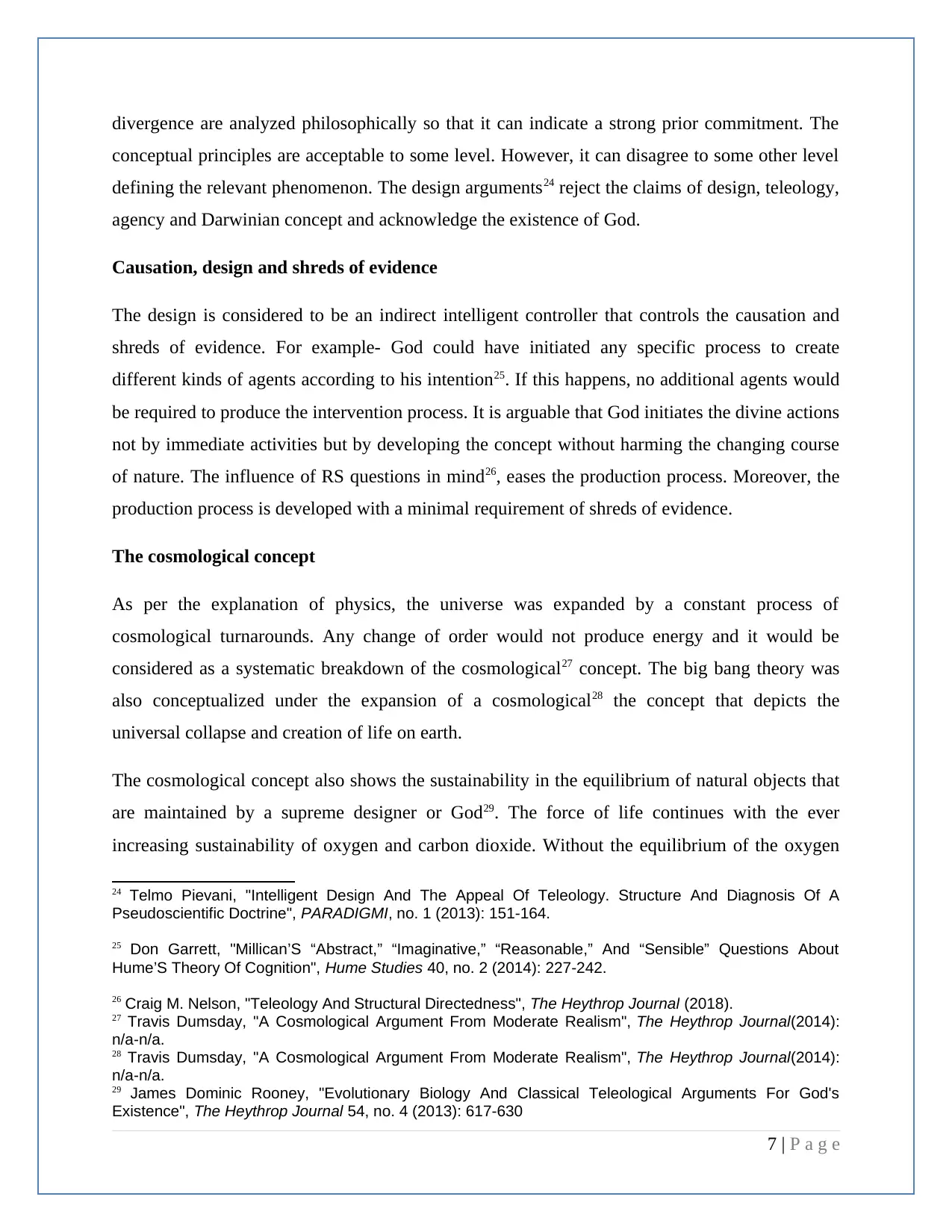
divergence are analyzed philosophically so that it can indicate a strong prior commitment. The
conceptual principles are acceptable to some level. However, it can disagree to some other level
defining the relevant phenomenon. The design arguments24 reject the claims of design, teleology,
agency and Darwinian concept and acknowledge the existence of God.
Causation, design and shreds of evidence
The design is considered to be an indirect intelligent controller that controls the causation and
shreds of evidence. For example- God could have initiated any specific process to create
different kinds of agents according to his intention25. If this happens, no additional agents would
be required to produce the intervention process. It is arguable that God initiates the divine actions
not by immediate activities but by developing the concept without harming the changing course
of nature. The influence of RS questions in mind26, eases the production process. Moreover, the
production process is developed with a minimal requirement of shreds of evidence.
The cosmological concept
As per the explanation of physics, the universe was expanded by a constant process of
cosmological turnarounds. Any change of order would not produce energy and it would be
considered as a systematic breakdown of the cosmological27 concept. The big bang theory was
also conceptualized under the expansion of a cosmological28 the concept that depicts the
universal collapse and creation of life on earth.
The cosmological concept also shows the sustainability in the equilibrium of natural objects that
are maintained by a supreme designer or God29. The force of life continues with the ever
increasing sustainability of oxygen and carbon dioxide. Without the equilibrium of the oxygen
24 Telmo Pievani, "Intelligent Design And The Appeal Of Teleology. Structure And Diagnosis Of A
Pseudoscientific Doctrine", PARADIGMI, no. 1 (2013): 151-164.
25 Don Garrett, "Millican’S “Abstract,” “Imaginative,” “Reasonable,” And “Sensible” Questions About
Hume’S Theory Of Cognition", Hume Studies 40, no. 2 (2014): 227-242.
26 Craig M. Nelson, "Teleology And Structural Directedness", The Heythrop Journal (2018).
27 Travis Dumsday, "A Cosmological Argument From Moderate Realism", The Heythrop Journal(2014):
n/a-n/a.
28 Travis Dumsday, "A Cosmological Argument From Moderate Realism", The Heythrop Journal(2014):
n/a-n/a.
29 James Dominic Rooney, "Evolutionary Biology And Classical Teleological Arguments For God's
Existence", The Heythrop Journal 54, no. 4 (2013): 617-630
7 | P a g e
conceptual principles are acceptable to some level. However, it can disagree to some other level
defining the relevant phenomenon. The design arguments24 reject the claims of design, teleology,
agency and Darwinian concept and acknowledge the existence of God.
Causation, design and shreds of evidence
The design is considered to be an indirect intelligent controller that controls the causation and
shreds of evidence. For example- God could have initiated any specific process to create
different kinds of agents according to his intention25. If this happens, no additional agents would
be required to produce the intervention process. It is arguable that God initiates the divine actions
not by immediate activities but by developing the concept without harming the changing course
of nature. The influence of RS questions in mind26, eases the production process. Moreover, the
production process is developed with a minimal requirement of shreds of evidence.
The cosmological concept
As per the explanation of physics, the universe was expanded by a constant process of
cosmological turnarounds. Any change of order would not produce energy and it would be
considered as a systematic breakdown of the cosmological27 concept. The big bang theory was
also conceptualized under the expansion of a cosmological28 the concept that depicts the
universal collapse and creation of life on earth.
The cosmological concept also shows the sustainability in the equilibrium of natural objects that
are maintained by a supreme designer or God29. The force of life continues with the ever
increasing sustainability of oxygen and carbon dioxide. Without the equilibrium of the oxygen
24 Telmo Pievani, "Intelligent Design And The Appeal Of Teleology. Structure And Diagnosis Of A
Pseudoscientific Doctrine", PARADIGMI, no. 1 (2013): 151-164.
25 Don Garrett, "Millican’S “Abstract,” “Imaginative,” “Reasonable,” And “Sensible” Questions About
Hume’S Theory Of Cognition", Hume Studies 40, no. 2 (2014): 227-242.
26 Craig M. Nelson, "Teleology And Structural Directedness", The Heythrop Journal (2018).
27 Travis Dumsday, "A Cosmological Argument From Moderate Realism", The Heythrop Journal(2014):
n/a-n/a.
28 Travis Dumsday, "A Cosmological Argument From Moderate Realism", The Heythrop Journal(2014):
n/a-n/a.
29 James Dominic Rooney, "Evolutionary Biology And Classical Teleological Arguments For God's
Existence", The Heythrop Journal 54, no. 4 (2013): 617-630
7 | P a g e
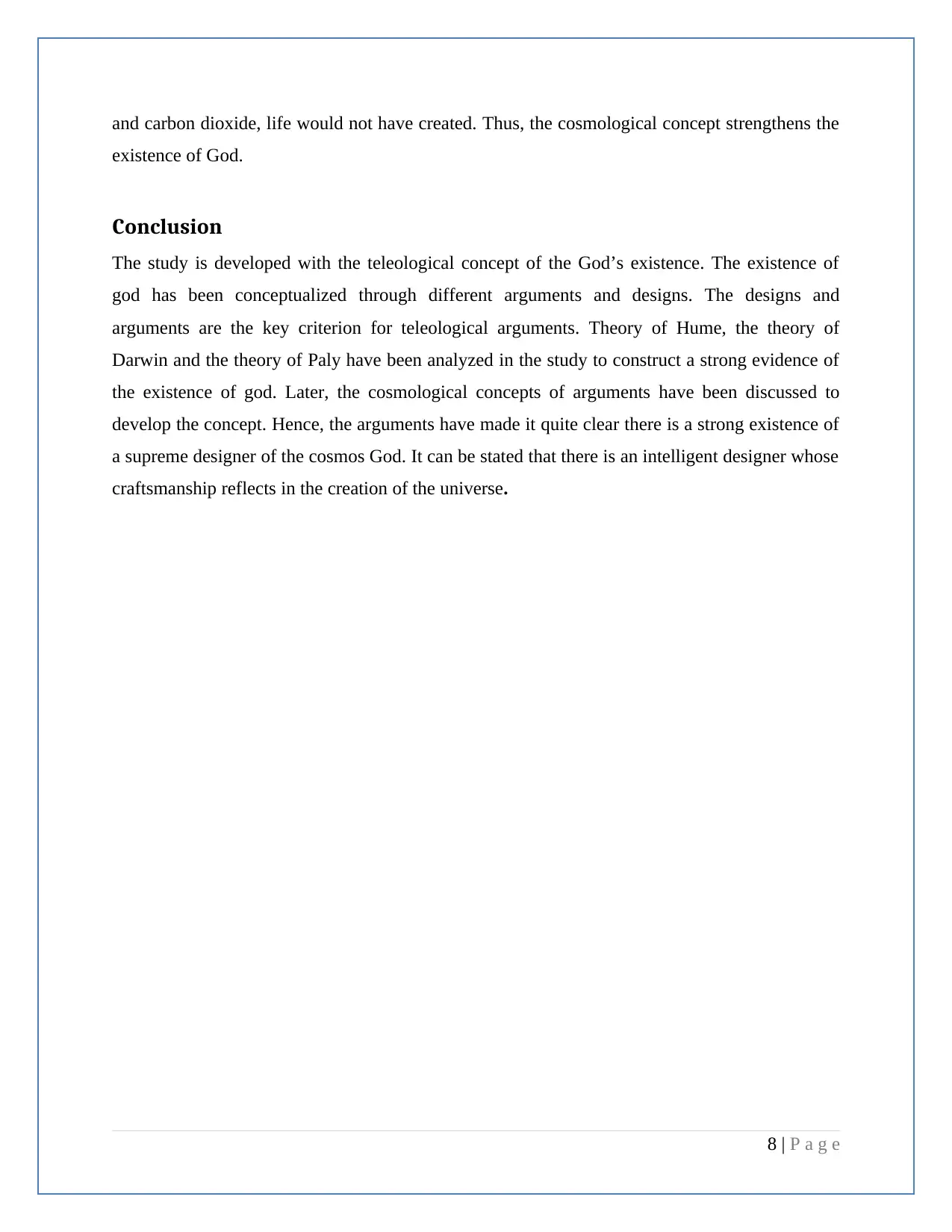
and carbon dioxide, life would not have created. Thus, the cosmological concept strengthens the
existence of God.
Conclusion
The study is developed with the teleological concept of the God’s existence. The existence of
god has been conceptualized through different arguments and designs. The designs and
arguments are the key criterion for teleological arguments. Theory of Hume, the theory of
Darwin and the theory of Paly have been analyzed in the study to construct a strong evidence of
the existence of god. Later, the cosmological concepts of arguments have been discussed to
develop the concept. Hence, the arguments have made it quite clear there is a strong existence of
a supreme designer of the cosmos God. It can be stated that there is an intelligent designer whose
craftsmanship reflects in the creation of the universe.
8 | P a g e
existence of God.
Conclusion
The study is developed with the teleological concept of the God’s existence. The existence of
god has been conceptualized through different arguments and designs. The designs and
arguments are the key criterion for teleological arguments. Theory of Hume, the theory of
Darwin and the theory of Paly have been analyzed in the study to construct a strong evidence of
the existence of god. Later, the cosmological concepts of arguments have been discussed to
develop the concept. Hence, the arguments have made it quite clear there is a strong existence of
a supreme designer of the cosmos God. It can be stated that there is an intelligent designer whose
craftsmanship reflects in the creation of the universe.
8 | P a g e
⊘ This is a preview!⊘
Do you want full access?
Subscribe today to unlock all pages.

Trusted by 1+ million students worldwide
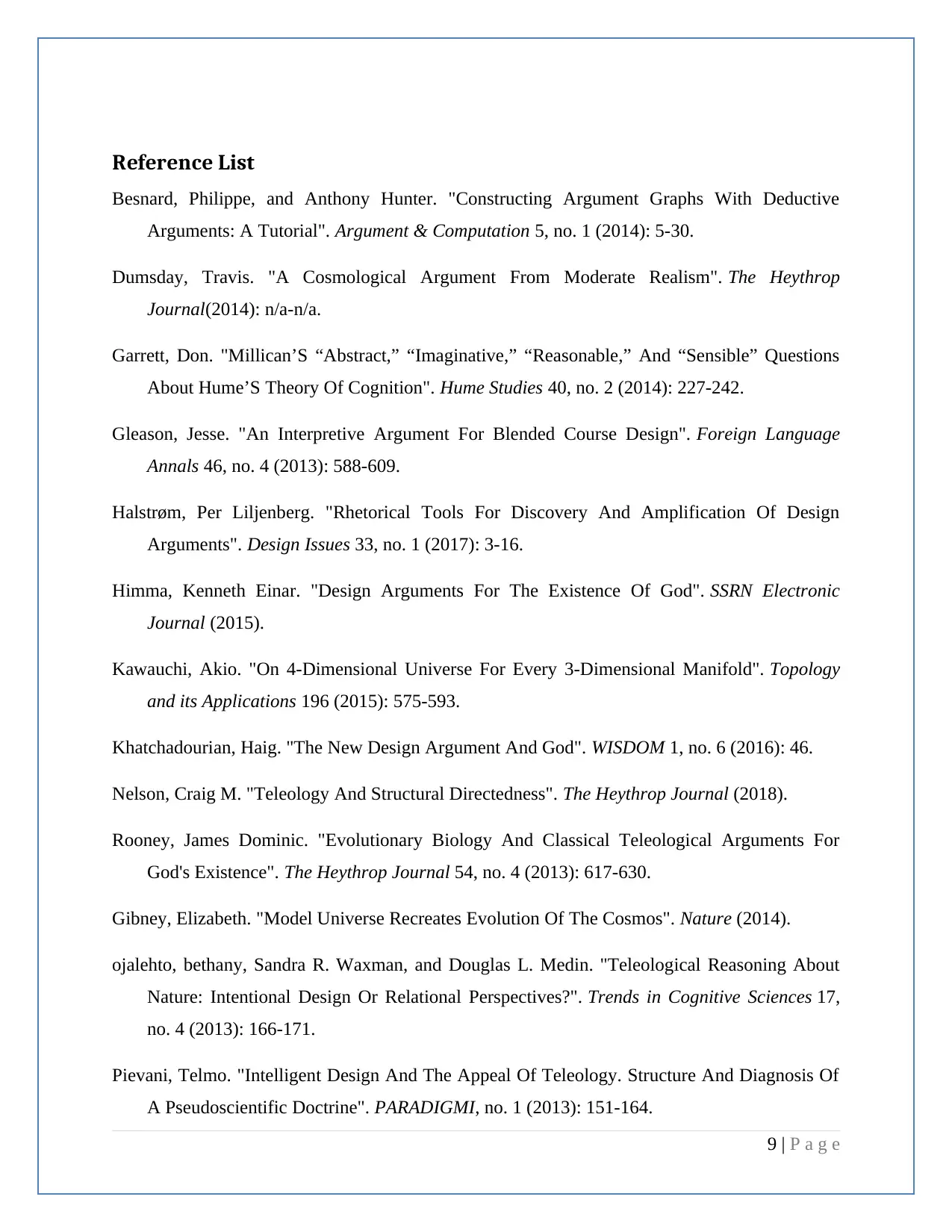
Reference List
Besnard, Philippe, and Anthony Hunter. "Constructing Argument Graphs With Deductive
Arguments: A Tutorial". Argument & Computation 5, no. 1 (2014): 5-30.
Dumsday, Travis. "A Cosmological Argument From Moderate Realism". The Heythrop
Journal(2014): n/a-n/a.
Garrett, Don. "Millican’S “Abstract,” “Imaginative,” “Reasonable,” And “Sensible” Questions
About Hume’S Theory Of Cognition". Hume Studies 40, no. 2 (2014): 227-242.
Gleason, Jesse. "An Interpretive Argument For Blended Course Design". Foreign Language
Annals 46, no. 4 (2013): 588-609.
Halstrøm, Per Liljenberg. "Rhetorical Tools For Discovery And Amplification Of Design
Arguments". Design Issues 33, no. 1 (2017): 3-16.
Himma, Kenneth Einar. "Design Arguments For The Existence Of God". SSRN Electronic
Journal (2015).
Kawauchi, Akio. "On 4-Dimensional Universe For Every 3-Dimensional Manifold". Topology
and its Applications 196 (2015): 575-593.
Khatchadourian, Haig. "The New Design Argument And God". WISDOM 1, no. 6 (2016): 46.
Nelson, Craig M. "Teleology And Structural Directedness". The Heythrop Journal (2018).
Rooney, James Dominic. "Evolutionary Biology And Classical Teleological Arguments For
God's Existence". The Heythrop Journal 54, no. 4 (2013): 617-630.
Gibney, Elizabeth. "Model Universe Recreates Evolution Of The Cosmos". Nature (2014).
ojalehto, bethany, Sandra R. Waxman, and Douglas L. Medin. "Teleological Reasoning About
Nature: Intentional Design Or Relational Perspectives?". Trends in Cognitive Sciences 17,
no. 4 (2013): 166-171.
Pievani, Telmo. "Intelligent Design And The Appeal Of Teleology. Structure And Diagnosis Of
A Pseudoscientific Doctrine". PARADIGMI, no. 1 (2013): 151-164.
9 | P a g e
Besnard, Philippe, and Anthony Hunter. "Constructing Argument Graphs With Deductive
Arguments: A Tutorial". Argument & Computation 5, no. 1 (2014): 5-30.
Dumsday, Travis. "A Cosmological Argument From Moderate Realism". The Heythrop
Journal(2014): n/a-n/a.
Garrett, Don. "Millican’S “Abstract,” “Imaginative,” “Reasonable,” And “Sensible” Questions
About Hume’S Theory Of Cognition". Hume Studies 40, no. 2 (2014): 227-242.
Gleason, Jesse. "An Interpretive Argument For Blended Course Design". Foreign Language
Annals 46, no. 4 (2013): 588-609.
Halstrøm, Per Liljenberg. "Rhetorical Tools For Discovery And Amplification Of Design
Arguments". Design Issues 33, no. 1 (2017): 3-16.
Himma, Kenneth Einar. "Design Arguments For The Existence Of God". SSRN Electronic
Journal (2015).
Kawauchi, Akio. "On 4-Dimensional Universe For Every 3-Dimensional Manifold". Topology
and its Applications 196 (2015): 575-593.
Khatchadourian, Haig. "The New Design Argument And God". WISDOM 1, no. 6 (2016): 46.
Nelson, Craig M. "Teleology And Structural Directedness". The Heythrop Journal (2018).
Rooney, James Dominic. "Evolutionary Biology And Classical Teleological Arguments For
God's Existence". The Heythrop Journal 54, no. 4 (2013): 617-630.
Gibney, Elizabeth. "Model Universe Recreates Evolution Of The Cosmos". Nature (2014).
ojalehto, bethany, Sandra R. Waxman, and Douglas L. Medin. "Teleological Reasoning About
Nature: Intentional Design Or Relational Perspectives?". Trends in Cognitive Sciences 17,
no. 4 (2013): 166-171.
Pievani, Telmo. "Intelligent Design And The Appeal Of Teleology. Structure And Diagnosis Of
A Pseudoscientific Doctrine". PARADIGMI, no. 1 (2013): 151-164.
9 | P a g e
Paraphrase This Document
Need a fresh take? Get an instant paraphrase of this document with our AI Paraphraser
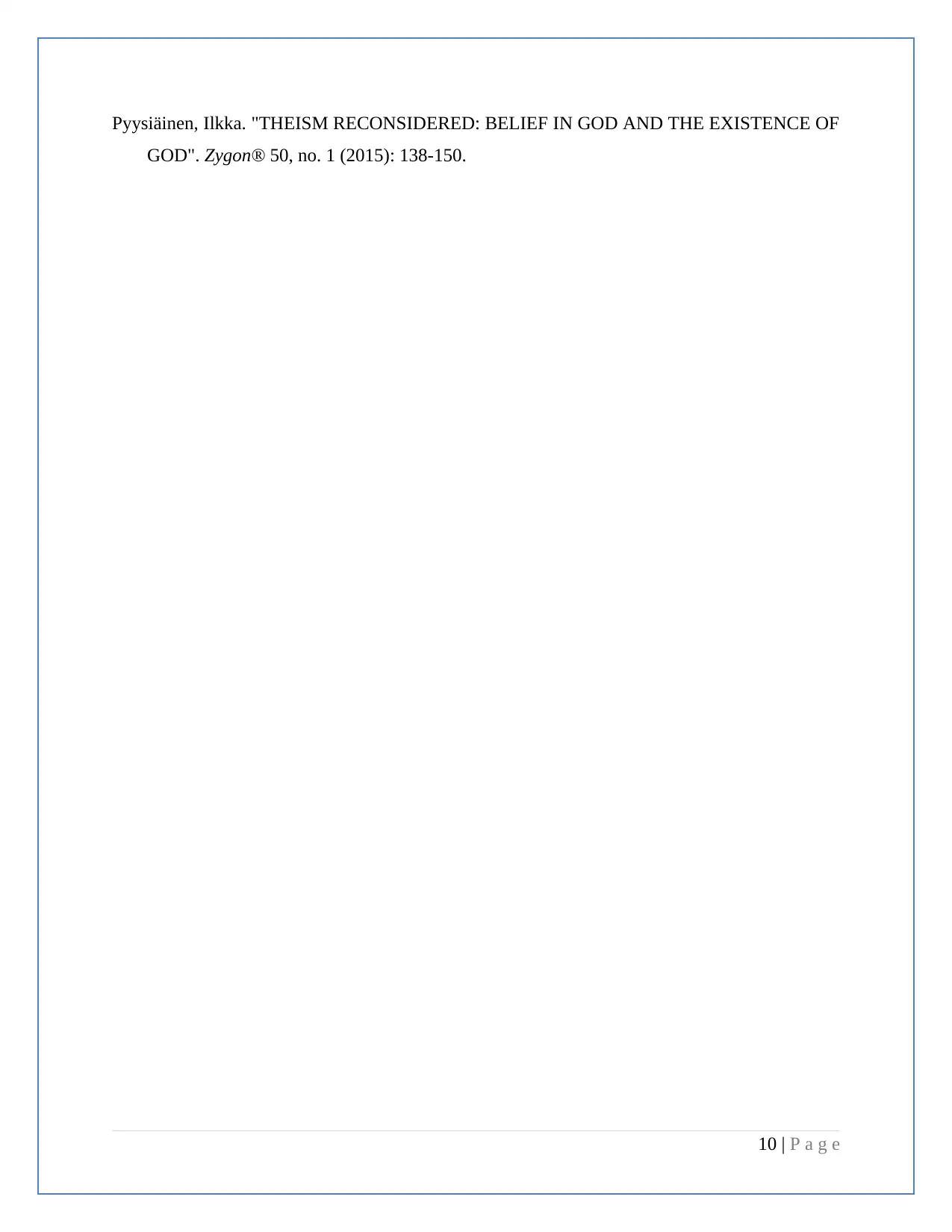
Pyysiäinen, Ilkka. "THEISM RECONSIDERED: BELIEF IN GOD AND THE EXISTENCE OF
GOD". Zygon® 50, no. 1 (2015): 138-150.
10 | P a g e
GOD". Zygon® 50, no. 1 (2015): 138-150.
10 | P a g e
1 out of 11
Your All-in-One AI-Powered Toolkit for Academic Success.
+13062052269
info@desklib.com
Available 24*7 on WhatsApp / Email
![[object Object]](/_next/static/media/star-bottom.7253800d.svg)
Unlock your academic potential
Copyright © 2020–2025 A2Z Services. All Rights Reserved. Developed and managed by ZUCOL.